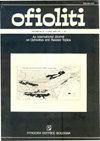双棱质幔壳转变(阿曼蛇绿岩)铬铁矿中硅酸盐包裹体的组成梯度揭示了受断裂控制的高温流体-熔融-岩石相互作用
IF 1.3
4区 地球科学
Q2 GEOLOGY
引用次数: 4
摘要
Maqsad地区地幔段和洋壳之间的过渡(阿曼蛇绿岩)主要由局部与铬铁矿矿体相关的可变浸渍的纯岩组成。在那里,邓质过渡带(DTZ)在地幔底辟之上发育,地幔底辟为MORB(前海洋扩张中心)提供了补给。然而,DTZ的纯岩中的斜方辉石和角闪石浸渍是水合岩浆作用的见证,该岩浆作用看起来仅限于该界面。另一个主要证据是散布在纯岩中的铬铁矿颗粒中的硅酸盐矿物的性质(如角闪石、斜方辉石、云母),这些矿物大多来自水合和富含二氧化硅的熔体或流体。在这里,我们报告了在马克萨德DTZ中详细采样的剖面上对此类夹杂物的研究。它提供了关于海洋扩展中心以下流体熔融橄榄岩反应过程的关键信息,与形成纯橄榄岩基质的间隙硅酸盐提供的信息互补。我们首先表明,包裹体的性质和成分与主纯橄榄岩中浸渍的性质和组成密切相关,然后所有材料沿横截面的化学演化与早期同岩浆阶段发育的断层的存在相关。这证实了深海岩石圈的早期构造主要控制着流体-熔融-岩石反应,并可以调节海洋扩张中心环境中的化学循环,包括卤素(Cl,F)本文章由计算机程序翻译,如有差异,请以英文原文为准。
COMPOSITION GRADIENTS IN SILICATE INCLUSIONS IN CHROMITES FROM THE DUNITIC MANTLE-CRUST TRANSITION (OMAN OPHIOLITE) REVEAL HIGH TEMPERATURE FLUID-MELT-ROCK INTERACTION CONTROLLED BY FAULTING
The transition between the mantle section and the oceanic crust in the Maqsad area (Oman ophiolite) is mainly made of variably impregnated dunites locally associated with chromitite ore bodies. There, the dunitic transition zone (DTZ) developed above a mantle diapir that fed with MORB the former oceanic spreading centre. However, orthopyroxene and amphibole impregnations in dunites from the DTZ are witnesses of a hydrated magmatism that looks restricted to this interface. The main other piece of evidence is the nature of silicate minerals included in chromite grains scattered in dunite (e.g., amphibole, orthopyroxene, mica), which are mostly issued from a hydrated and silica-rich melt or fluid. Here, we report on a study of such inclusions along a section sampled in detail in the Maqsad DTZ. It brings critical information on the processes involved in the fluid-melt-peridotite reaction below oceanic spreading centres, complementary to the one provided by the interstitial silicates forming the matrix of the dunite. We first show that both the nature and the composition of the inclusions are well-correlated to those of the impregnations in the host dunites, then that the chemical evolution along the cross-section for all materials correlate to the presence of faults that developed at an early, syn-magmatic stage. This confirms that the early tectonics in the deep oceanic lithosphere primarily controls the fluid-melt-rock reactions and can condition chemical cycling, including for halogens (Cl, F), in oceanic spreading centre setting
求助全文
通过发布文献求助,成功后即可免费获取论文全文。
去求助
来源期刊

Ofioliti
地学-地质学
CiteScore
2.40
自引率
7.70%
发文量
1
期刊介绍:
Since 1976, Ofioliti provides an international forum for original contributions and reviews in the field of the geodynamics, petrology, geochemistry, biostratigraphy, stratigraphy, tectonics and paleogeography applied to ophiolitic terrains and modern oceanic lithosphere, including their sedimentary cover. Studies of topics such as geodynamics of the mantle, the evolution of orogens including ophiolites and paleoceanography are also welcome
 求助内容:
求助内容: 应助结果提醒方式:
应助结果提醒方式:


